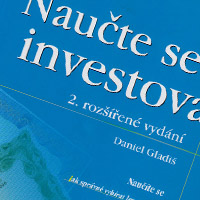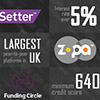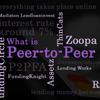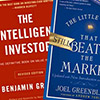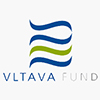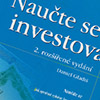Learn to Invest by Daniel Gladis
In my recent blog, ‘The Top Five Books Every Investor Should Read‘, I wrote of how tough it was to leave a title by David Gladis off the list. This post is my way of making up to Gladis for having him miss out last time!
The book Learn to Invest by Daniel Gladis is a very simply written investment book, supplemented by practical real screening criteria. The book was published in 2004 only in my native language (which is Czech) with the title "Naučte se investovat". Unfortunately has not yet been translated into English. But because this was my first investment book which I read (2009), and my basic strategy has been based on since – although, I developed over the time - I decided to share it with you here.
About Daniel Gladis
 Daniel Gladis is a graduate of the Brno University of Technology in the Czech Republic. Between 1991-1994 he studied at Brno’s Masaryk University and the Faculty of Economics and Management in Utrecht (Netherlands). In 1999 he received his MBA from Rushmore University in the US.
Daniel Gladis is a graduate of the Brno University of Technology in the Czech Republic. Between 1991-1994 he studied at Brno’s Masaryk University and the Faculty of Economics and Management in Utrecht (Netherlands). In 1999 he received his MBA from Rushmore University in the US.
In 1993, with two partners, Gladis founded Atlantik Financial Markets, Inc., where he stayed as a director until 1999. From 1999-2004 he served as Director and Chairman to the Board of Directors in ABN AMRO Asset Management. In 2004 he established the first hedge fund in Central Europe - the Vltava Fund SICAV Plc, where he currently holds the CEO position.
You have everything in your hands. Even the fact whether you become a successful investor.(Daniel Gladis)
Gladis represents the school of investing which places emphasis on value investing with long-term positions. His strategy is based on the time-proven philosophy of Warren Buffett (in respect to Benjamin Graham). This is just one of the reasons he is often called the Czech Buffett.
Vltava Fund SICAV, Plc
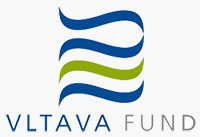 The Vltava Fund SICAV Plc. is a profitable fund with historical NAV growth of 58.70% and is the very first hedge fund in Central Europe, having been established in September 2004. Although during the financial crisis in 2008 it recorded huge losses (approximately -80%, a figure which would have been catastrophic for others), the Vltava Fund immediately bounced back in 2009 to score its greatest success ever when it was named the most successful hedge fund in the world (source: Hedge Funds Review) with reflected NAV growth of 201%!
The Vltava Fund SICAV Plc. is a profitable fund with historical NAV growth of 58.70% and is the very first hedge fund in Central Europe, having been established in September 2004. Although during the financial crisis in 2008 it recorded huge losses (approximately -80%, a figure which would have been catastrophic for others), the Vltava Fund immediately bounced back in 2009 to score its greatest success ever when it was named the most successful hedge fund in the world (source: Hedge Funds Review) with reflected NAV growth of 201%!
Learn to invest in brief
The investment strategy put forward in this book is rooted in the approach of Benjamin Graham and Warren Buffett. This means that Gladis’s strategy is based upon fundamental analysis and long-term investment strategy. One of Gladis's thoughts are going ‘upstream’ and using modern investment theory: too much diversification leads to crumbled, average returns. Therefore, he recommends holding the portfolio of up to 15 companies on which an investor has strong opinions on.
Wide diversification is only required when investors do not understand what they are doing.(Warren Buffett)
Below are the details of what each chapter (the opening chapter is just an introduction) of Learn to Invest has to offer:
Chapter Two: Investment and speculation
This chapter is mainly focused on the theoretical part of investing and the fundamental principles which young investors should adhere to. The key point is to explain the difference between investments and speculations and why it is good to avoid speculation of any sort. Topics that are also discussed relate to market efficiency, the concept of risk, diversification and safety margins.
Chapter Three: Intrinsic value
The second chapter relates exclusively to the intrinsic value of shares and their assessment. Gladis presents a basic analysis of company financial statements and reports and continues with the analysis of two basic approaches to determine the intrinsic value of shares. For better comparison of two companies, Gladis introduces six basic finance indicators such as: Price to Earnings ratio (PE), Earning Per Share (EPS), Price to Sales ratio (PS), Price to Book ratio (PB), Dividend yield (DY) and Return On Equity (ROE) etc.
Chapter Four: Investment philosophy and strategy
Just as with elite athletes or professional poker players, psychology plays a key role in the investing process. Unfortunately, many new investors ignore this key question (I can speak from my personal experience). Gladis here explains how to recognise our own mistakes and the mistakes of others and how to understand what causes them and how to avoid them.
Chapter Five: The investment process
Although this chapter is presented as a description of the investment process, in fact, it is dedicated to the correct use of screening criteria in the real world and the subsequent analysis of selected companies (unfortunately, the links to screening portals that Gladis refers to no longer work, but these days we have many alternatives). The chapter concludes by addressing the question of when is the best time to sell your shares.
Good company is not the same thing as a good investment.(Daniel Gladis)
Chapter Six: The psychology of investing
Just as with elite athletes or professional poker players, psychology plays a key role in the investing process. Unfortunately, many new investors ignore this key question (I can speak from my personal experience). Gladis here explains how to recognise our own mistakes and the mistakes of others and how to understand what causes them and how to avoid them.
Chapter Seven and Eight: What is in the book that did not fit
The final two chapters of Learn to Invest are not focused on a particular topic but include a subset of additional topics that are important for investing. However, the book does not give them too much space. They relate to asset allocation, foreign currency risk, taxes, inflation, transaction costs, investing through mutual funds, indices, benchmarking and long vs. short positions.
Bottom line
For me, this short book (160 pages) has been like an ‘investment bible’. Although I would recommend a much wider range of great investment books today, it simply was the first book I read about investments and I am very nostalgic about it.
When you revisit a title you read many years ago, it’s quite interesting to see what inner development you have gone through over the years and how your approach to investments changes and reforms over a period of time. Flicking through the pages again today, I realise how much my focus and philosophy has shifted onto different things than when I first read the book about six years ago.

